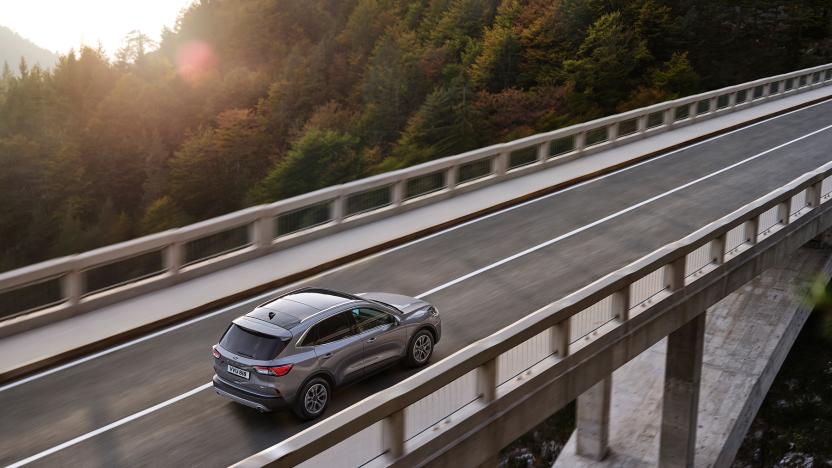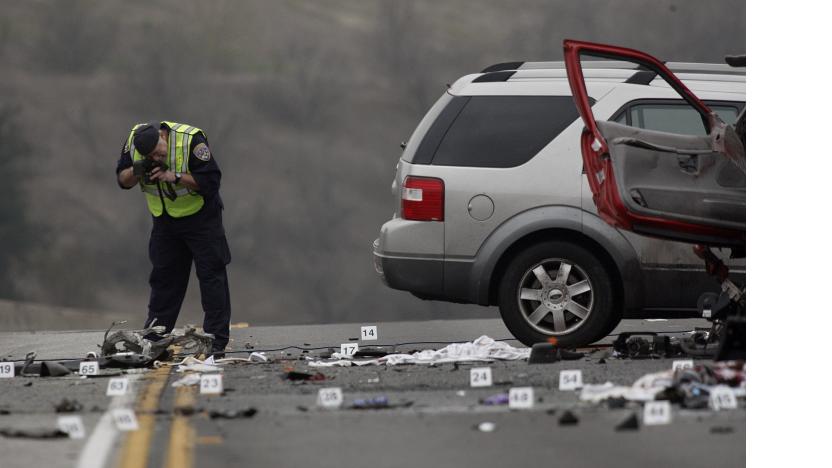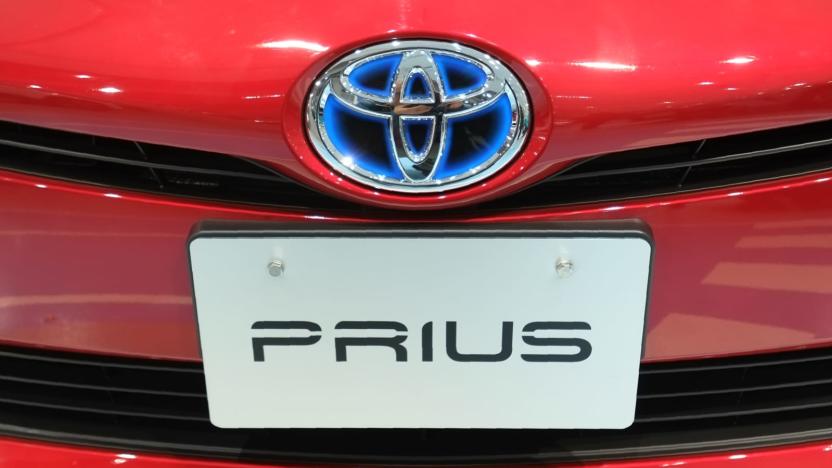v2v
Latest

Ford begins sharing its driver-collected accident data with other car makers
That’s why Ford has started sharing its own car data, which includes airbag activations, emergency braking and fog light usage, with other manufacturers.

Study says road deaths could be cut in half if more safety tech were standard
Consumer Reports has released a study estimating that road deaths could be halved if automatic braking and other safety features were standard on every car.

Volkswagen unveils next-gen Golf and its hybrid variants
After months of teasing, the eighth generation of the Volkswagen Golf has been unveiled. The sleeker design doesn't stray too far from the vehicle's core look. But like our moms always told us, it's what inside that counts and the new Golf has a lot going on under the shell.

Most of Toyota's cars will talk to each other by 2025
Toyota's first vehicles that communicate with each other will be up for sale in the US starting in 2021. By the mid-2020s, "most" of Toyota and Lexus' lineup will feature Dedicated Short-Range Communications (DSRC) the company says. Since 2015, the automaker has installed the tech in around 100,000 cars in its native Japan, according to Reuters. The automaker pointed toward its automatic emergency braking systems pledge from 2015 as proof of intent. Now, Toyota says 92 percent of its US sales are cars with its Toyota Safety Sense or Lexus Safety Sense braking tech as standard equipment.

Networked self-driving cars are smarter and safer
You know what's better than one self-driving car on the road? Two, because then they can pool resources. Vehicle-to-vehicle (V2V) communication isn't anything new, of course, but researchers at Switzerland's federal institute of technology, EPFL, are taking things one step further. By wirelessly connecting the LIDAR, sensors and navigation systems of two cars in convoy, both can get a fuller picture of the world around them.

It takes a smart city to make cars truly autonomous
Artificial intelligence is driving the autonomous car. Coupled with robust computers, automobiles of the future will be more powerful than any other device we own. But they'll only be as powerful as their surrounding allows. If your vehicle doesn't know about a traffic jam along its route, like its human counterparts, it'll get stuck in gridlock. That's where connectivity comes in. When self-driving cars hit the road, they'll not only be computing juggernauts but also sharing data with everything all the time.

Researchers give driverless cars better cooperation skills
Are you really ready to ride with just a robot at the wheel? To make self-driving cars safer, researchers from the École Polytechnique Fédérale de Lausanne (EPFL) in Switzerland want them to communicate both with each other and non-robotic vehicles to avoid any nasty surprises. As such, they rigged up three vehicles, including a robotic truck and non-autonomous vehicle, to function as one unit on a real road. By working in a team and using each others' sensors, the vehicles were able to anticipate each others' moves, making lane change maneuvers safer.

The US wants cars to 'talk' to each other, sooner rather than later
The Department of Transportation wants America's cars to talk to each other, and it wants that to happen pretty soon. That's why Secretary Anthony Foxx has announced that legislation to make vehicle-to-vehicle (V2V) communication a mandatory feature of new cars will be brought forward. At a speech in Silicon Valley, the official added that he's greasing the wheels of government to make it easier for the program to begin. For instance, he's working with the FCC to ensure that the 5.9GHz spectrum is properly tested and ready for use when this technology eventually reaches consumers in the next few decades.

GM: A Cadillac that can (almost) drive itself is coming in 2016
We've talked a lot about autonomous driving developments like Google's self-driving car, but today in Detroit GM CEO Mary Barra is announcing her company's push to put similar technology in cars we can actually buy. Two years from now, Cadillac will launch an all-new car with its "Super Cruise" technology that not only holds your speed, but uses sensors to keep it in the middle of the lane, and can brake if necessary. We've ridden in a demo vehicle that could even steer to avoid obstacles, but what's coming is more limited (likely because of legal and insurance questions that have yet to be answered), and says it will provide comfort to "an attentive driver" -- hopefully with enough leeway for us to snap an in-traffic selfie or two.

Volvo's connected cars could make winter driving safer for everyone
With its latest research project, Volvo is hoping to make driving in inclement weather a bit less dicey. The Swedish automaker is testing a safety system that uses mobile data networks to relay icy road conditions from vehicle to vehicle. Once you hit a slick spot, the location data uploads to Volvo's database and then an instant notification is sent to other cars nearing that area. As the outfit tells it, the in-car app will adjust the warning's intensity based on your speed as well as the road conditions. Meaning that, if you're crawling up the interstate at 5MPH through a whiteout, your dashboard won't light up in the way that, say, someone's would if they were doing 88MPH. What's more, the system will transmit the pavement-friction data to maintenance crews, so more (or less) salt and snowplows can be deployed in a given area, making the roads safer for everyone -- not just Volvo owners. The pilot program is limited to some 50 vehicles for now, but the firm promises that next winter the fleet'll grow "considerably."

The government wants our cars to 'talk' to each other
The US Department of Transportation (DOT) is throwing its weight behind vehicle-to-vehicle (V2V) communication systems. After years of experimentation and a real-world trial in Ann Arbor, MI the government is (almost) ready to make peer-to-peer networking a required safety feature on all new cars. The National Highway Traffic Safety Administration (NHTSA) has announced that it'll "begin taking the next steps" towards implementing V2V, though, what those steps are is still somewhat shrouded in mystery. One major detail left to be ironed out is when exactly these new safety standards will go into effect. The agency is currently finalizing its analysis of the data gathered during the Ann Arbor trial, which it will then use to build a regulatory proposal. For those that don't know, V2V systems allow cars to share information about their position, speed and heading with each other and alert a driver when there is potential for danger. That could be a car speeding through an intersection ahead or a truck in your blind spot when trying to change lanes. While there is potential for integration with automated collision avoidance technology in the future, initially the DOT will be focused on passive systems. If you're concerned about the government having yet another avenue through which to track you, breathe easy. The data passed between vehicles includes no personally identifiable information. In fact, it doesn't even identify the car -- it only contains basic safety data. In addition to that, the NHTSA envisions multiple layers of security and privacy protection to ensure vehicles are sending and receiving reliable data.

US Transportation agency backs public use of self-driving cars, urges states to adopt legislation
The key to road safety may lie in self-driving cars. That's the general conclusion of the National Highway Traffic Safety Administration's recently released policy report which urges states to draw up legislation that encourages testing of automated autos. Currently, only three states (i.e., California, Nevada and Florida) have enacted laws that permit companies like Google to operate these vehicles on public roadways. But the NHTSA hopes that with more state-backed adoption, advances in vehicle-to-vehicle communication and automatic braking can more quickly be refined, thus paving the way for industry standards and eventual commercial deployment. The agency, an arm of the US Department of Transportation, is also conducting its own research into V2V systems and driver guidelines for self-driving cars; the first phase of which is set to play out over a four-year period. For now, though, it still has a few additional hurdles to overcome, namely consumer perception (the NHTSA estimates self-driving cars could reduce crashes by 80 percent) and possible WiFi interference from the whitespace spectrum freed up by the FCC. Though the NHTSA's sights are clearly set on an automated vehicle future, it's yet to determine whether or not inclusion and use of that tech will be mandated.

Vehicle-based networks get sexy names, remain impractical
While the idea of the networked car has been simmering on the back burner for years now, the farthest we've gotten is niche single-vehicle products like AutoNet -- but a pair of new proposed systems could actually get past the drawing aboard before flaming out and failing like all the rest. The first is a collision-avoidance system being developed in Europe called Vehicle2Vehicle (or V2V), which uses GPS and wireless networking to constantly analyze the speed, position and trajectory of nearby cars and alert drivers to impending collisions. The developers say the tech is simple enough to be deployed relatively rapidly, but that the mess of different in-car integration standards is keeping costs high and interest low -- which is the same problem faced by the developers of a different system called CarTorrent at UCLA. CarTorrent is more about getting cars connected, and it's pretty much what the name implies -- distributed networking across cars. The system is based on something called digital short range communication over the 5.9GHz spectrum, and it allows cars to transmit and receive navigation, media, and telemetry information -- and what's more, it's based on a proposed IEEE car-to-car networking standard called 802.11p, which should speed adoption by automakers when it's finally approved. Even still, we've been burned too many times in the past to keep our hopes alive -- guess it's back to eBay for that KITT auction.Read - V2VRead - CarTorrent








